Changes to London Low Emission Zone Legislation
London’s air pollution is increasing people’s risk of asthma, and heart and lung disease. Especially those who work and live there. Vehicles on the roads are the largest source of emissions which are damaging the health of the capital’s citizens. The date is set for changes to the London low emission zone legislation.
After October 2020, there will be changes to the existing Low Emission Zone (LEZ) legislation. 4×4 pick-ups and caravans will join a group of larger vehicles. This group will need to meet new emissions criteria in order to operate within the M25. These vehicles will join HGVs, coaches and buses who already operate within this specific criterion. The Government are taking action along with Transport for London (TFL) to clean up the polluted air in order to vastly improve the public health of people.
History of the London Low Emissions Zone
The first Ultra Low Emission Zone was introduced in April 2019 by the Mayor of London to clean up London’s polluted air. The zone is in place due to the risk air pollution posed to those who live, work and visit. Those who suffer the most from London’s toxic fumes are those with underlying respiratory conditions and the elderly. Children are also in the “vulnerable” category. In locations with illegal pollution levels, there are over 360 primary schools. These individual groups will consequently benefit from the changes to legislation.
Half of the emissions of nitrogen oxides originate from transport in London, on estimate. These contribute to illegal nitrogen dioxide levels and particulate matter (emissions of dust). These are severely detrimental to those with chronic illnesses. They also reduce life expectancy and affect lung development.
The majority of the transport entering London will now be from outside London’s zone, reducing emissions within London.
Other cities across the UK such as Birmingham, Derby, Leeds, Nottingham and Southampton are all urged to introduce a Clean Air Zone. 2021 is the Government’s goal to bring nitrogen dioxide levels down within a legal limit. If you own a vehicle larger than a car, it may be wise to check and take the necessary steps to avoid financial penalties later in the year.
Drivers who do not comply and enter the zone after the October 2020 changes will be charged extra. On top of the £11.50 congestion charge, there is an extra £12.50 fee. Charges apply once in a 24-hour period and this would apply seven days a week, 365 days a year.
For more information, you can check your vehicle’s Euro Emission Standard here.
If you’re interested in a green car salary sacrifice scheme for your company, contact us today!
Tags : Air Pollution, Low Emissions

